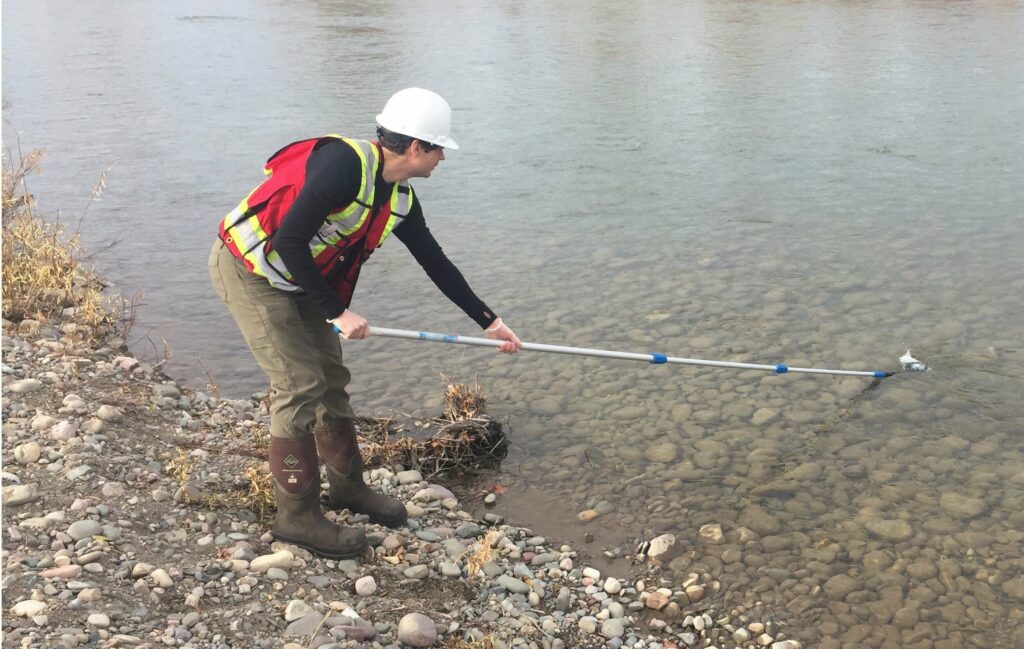Invisible Genetic Codes in Streams and Lakes Reveal What Species are Present!
DNA in the environment
Every living thing, from a single cell amoeba to the largest Blue Whale, is constantly interacting with its environment, absorbing what’s needed to sustain life and expelling what’s not. Skin tissue, scales, or individual cells sluff off organisms and are expelled as feces, urine, or gametes. Along with this waste, all living things leave behind their DNA and a unique genetic fingerprint. Environmental DNA, or eDNA, is any DNA that is collected from the environment.
Why use eDNA?
Finding certain species in aquatic environments can be challenging. Accurately and precisely mapping where they are can be time consuming and costly. eDNA is a rapidly growing technology that’s use is skyrocketing to monitor fish and amphibians in complex environments by:
-
assessing changes in where, when, and even how many organisms are present;
-
keeping track of biodiversity at the scale of rivers and entire watersheds;
-
detecting invasive species; and
-
assessing the effectiveness of fish exclusion devices.
eDNA is becoming the ‘go to’ approach that industry, government, and environmental professionals are using to address challenging regulatory demands, as well as expectations from the public and stakeholders. High accuracy, precision, and detection probabilities can be maintained over large areas and long time periods just by increasing the number or frequency of water samples collected. Results can be available quickly, often in days or weeks, so it is very cost effective by reducing labour associated with trapping or electrofishing. Sampling eDNA is also very versatile; it can be collected at any time of the year, rain or shine, during the open water season or from under the ice in winter. It’s non-invasive, with no risk of mortalities. There’s also no need to wait for the instream work window (as you would when you’re capturing and handling fish), to apply for sampling permits, or spend time submitting data returns to the government. There’s also a lower risk of spreading aquatic invasive species.
False positives and negatives
False positives are when you think an organism, like fish, are present, but they’re not. Time and money get wasted trying to protect or remove fish in an affected area when they aren’t there to begin with. These errors can happen when DNA from another source contaminates the sample or the lab assay misidentifies the DNA in the sample. However, they also often happen when organisms, like fish, are simply assumed to be present based on an unreliable observation or outdated information.
False negatives are when you don’t think fish are present, but they are, and there’s a risk something’s done that harms the fish resulting in regulatory penalties and fines, approval delays, and potential impacts on public relations and social license. False negatives can happen when an eDNA sample is poor quality or something is wrong with the eDNA assay. False negatives are common with conventional, non-eDNA, survey methods as well. Organisms like fish aren’t always detected in low densities when the methods used are inadequate for the environment being sampled.
AJM and the eDNA labs we work with follow the strongest standards in the industry to avoid false positives and false negatives, with protocols in place at every step along the way from assay development and validation, to study design and site selection, to sample collection, filtration, and preservation, to data analysis and interpretation.
How AJM is using eDNA
AJM is currently working with First Nation clients on Alberta’s East Slopes and in the Oil Sands region to help them answer questions with eDNA that would take substantially more resources to answer using traditional sampling methods. The efficiencies and cost savings associated with eDNA allow our clients to evaluate fish entrainment, identify previously undocumented populations of federally listed species at risk, survey overwintering habitat, and evaluate fish passage upstream of culverts to identify potential fish habitat offsetting options and restoration opportunities.
Furthermore, fin clips that AJM has collected from populations of native and non-native trout and Arctic Grayling, as well as eDNA samples from occupied sites, are being used to validate targeted species-specific eDNA assays. These assays are then being made available to all stakeholders, including industry, as new tools to assess risks and protect sensitive fish populations.
Whether you are looking for a rare species you need to protect, wanting to demonstrate to a regulator that an organism is not present, are hoping to stop a non-native species invasion before it happens, or demonstrate that an invasive species has been eradicated, eDNA can provide the precise and accurate results you need and at AJM we have the expertise to guide you through the process.
